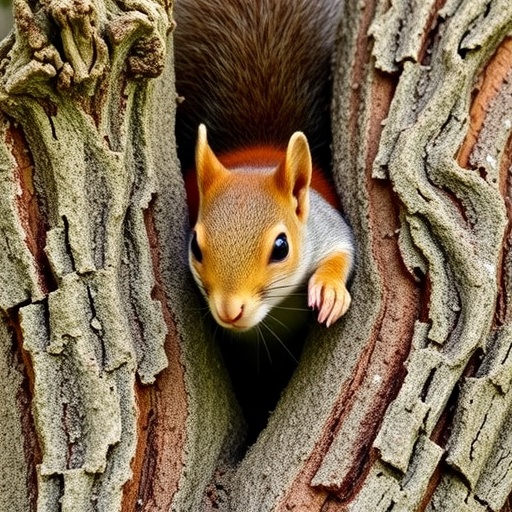
In a groundbreaking study published in the esteemed journal Scientific Nature, researchers have traced the intricate dynamics between arboreal arthropods and their immediate environment, specifically focusing on the impacts of simulated landings by squirrels on these organisms. The investigation, spearheaded by Seiler, Schleff, and Gamsky, addresses a critical yet often overlooked facet of ecological interaction—how animal behaviors, in this case, the landings of squirrels, create ripples through their ecosystems. This study comprehensively explores both physical and behavioral responses observed in ants and various other arboreal arthropods, signifying a novel avenue for understanding interspecies interactions and environmental adaptation.
To set the stage for their investigation, the researchers meticulously recreated the landing scenarios of squirrels, arguably the key players in arboreal ecosystems. Utilizing a combination of experimental setups that included the use of artificial branch modules, the team was able to simulate the type of disturbances caused by these agile mammals as they move through their canopy-dwelling habitats. This framework allowed the scholars to recreate realistic conditions under which the native species would normally operate, providing a robust platform to observe their reactions and adaptations.
The responses of ants, a keystone species in many forest ecosystems, were of particular interest. Their behavior can offer insights into how disturbances affect not merely their immediate survival but also their long-term evolutionary trajectories. The research showed that when squirrels landed, a heightened level of agitation and relocation among ant populations was observed. These reactions can lead to immediate consequences, such as altered foraging behaviors as ants scramble to avoid potential predation or other threats associated with large mammals invading their space.
Interestingly, the study reported that the structural integrity of the microhabitats occupied by these insects was also compromised following the simulated landings. This has far-reaching implications not merely for the ants but also for the extended community of arthropods that share these niches. The presence of squirrels triggers a cascade of disturbances that can shift entire community dynamics. A seemingly innocuous event in the canopy can have profound and lasting effects on the ability of these species to thrive.
Collaboration took a central role in the execution of this study. By bringing together ecologists, entomologists, and behavioral scientists, the team leveraged diverse expertise to unravel the complex interplay of environmental factors and animal behavior. This interdisciplinary approach facilitated a more granular analysis of not just the reactions seen during the experiments but also the broader implications for species resilience and adaptation in a rapidly changing world.
Furthermore, this research compels a reconsideration of ecological theories concerning species interactions. Traditional models often focus on predatory relationships or competition for resources, neglecting the profound effects that even benign behaviors—such as the landings of a squirrel—can have on community structures. The team urges the scientific community to expand their lens and consider how interspecies interactions extend beyond direct competition and predation.
As urbanization and habitat destruction continue to escalate, the findings of this research become increasingly pertinent. The study posits that understanding and mitigating the effects of landscape alterations on complex ecological interactions is essential for effective conservation strategies. If populations of key species, like squirrels and ants, are significantly affected by habitat loss, the repercussions will ripple through entire ecosystems, potentially leading to biodiversity declines.
The study’s innovative methodology also sets a benchmark for future research in similar domains. Utilizing technology—such as motion detection and high-speed cameras—the researchers were able to capture fleeting moments of interaction and reaction. This methodological advancement may inspire further investigations aimed at uncovering the nuanced responses of other species to various environmental stressors, fostering a deeper understanding of ecological balances and imbalances.
Alongside the ecological considerations, the researchers addressed potential applications of their findings in urban planning and wildlife management. By identifying the specific behaviors that contribute to an ecosystem’s resilience, strategies could be devised to foster more harmonious coexistence between urban environments and wildlife. The promotion of urban forests or green spaces could serve as essential refuges for these species, allowing them to maintain their roles as ecological stalwarts.
The implications of this research extend beyond mere academic curiosity; they touch on vital environmental issues such as climate change and habitat fragmentation. As the planet’s ecosystems face unprecedented pressures, understanding the intricate web of life becomes crucial if we are to develop sustainable solutions. The information gleaned from such investigations is invaluable for informing public policy and conservation efforts aimed at preserving biodiversity in an ever-evolving landscape.
In conclusion, the study by Seiler, Schleff, and Gamsky is a pivotal addition to the ecological literature. By shedding light on the effects of simulated squirrel landings on ants and other arboreal arthropods, the researchers not only advance our scientific understanding but also underscore the interconnectedness of ecosystems. It is these nuanced interactions that will ultimately dictate the health of our environments in the face of relentless change—a testament to the resilience of nature and the inherent complexity of the world’s ecosystems.
This study serves as both a call to action and a foundation upon which future research can build, reminding us of the delicate balance that exists within our natural world and the significant consequences that can result from seemingly ordinary interactions. As we tread further into the nuances of these ecosystems, the importance of considering multiple layers of interaction has never been more apparent.
Subject of Research: Impacts of simulated squirrel branch landings on ants and arboreal arthropods.
Article Title: Effects of simulated squirrel branch landings on ants and other arboreal arthropods.
Article References: Seiler, A.R., Schleff, E.J., Gamsky, O.M. et al. Effects of simulated squirrel branch landings on ants and other arboreal arthropods. Sci Nat 112, 42 (2025). https://doi.org/10.1007/s00114-025-01993-1
Image Credits: AI Generated
DOI: https://doi.org/10.1007/s00114-025-01993-1
Keywords: squirrel behavior, arboreal arthropods, ecological interactions, species resilience, environmental adaptation.
Tags: ant behavior in ecosystemsarboreal arthropod interactionscanopy ecosystem researchecological adaptation of antsecological effects of animal disturbancesenvironmental impact of mammalsexperimental study on forest dynamicsinterspecies interactions in forestsresearch on keystone speciessimulated disturbances in naturesquirrel behavior and environmentsquirrel landings impact on ecosystems





